
Cuisenaire rods are colored wood or plastic rods. The rods all have a cross section of 1 cm x 1 cm, with varying lengths. Each color is associated with a different lengths.

It's easier to remember which color is which length if you look for patterns.
Why and when? Cuisenaire rods have the advantage and the disadvantage over counters that it's not easy to count by ones with Cuisenaire rods. This makes them too hard for kindergarten (mostly), but they encourage combining numbers by looking at them as combinations of other numbers rather than counting by ones. I think second grade is a good time to introduce Cuisenaire rods (a manipulative representation, but encouraging strategies other than counting by ones).
When you add and subtract with Cuisenaire rods, you do it by matching lengths. For instance:
In this first example, we have the rods for 4 and 3 end to end, and lined up with the rod for 7. This shows that 7 is the length of 4 and 3 together (4+3=7) The second example is similar, with rods for 8 and 5 end to end on the top, but because 8+5 is greater than 10, we can't represent the sum with a single rod, and instead we have 10+3 as the sum. In the third example, to subtract 9 from 2, we line them up side by side, and look for the missing piece. You can think of this as comparing 9 and 2 and finding the difference, or you can think of it as saying 9 can be split into two parts: 2 and 7, so if you took away 2, you would have 7 left. The fourth example is similar to the third, but the minuend, 13, is greater than 10 so it is represented by two rods: 10+3, instead of just one. |
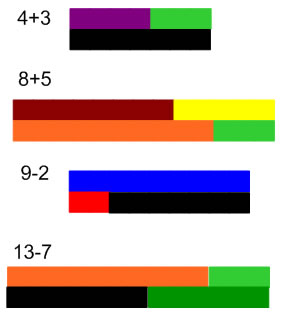 |
It doesn't matter whether the whole is on top and the parts are on the bottom (as I have it for the subtraction problems) or if the whole is on the bottom and the parts are on top (as I have the addition problems shown)--it only matters that the lengths line up so you are showing things that are equal. Physically making these equations using Cuisenaire rods involves some experimenting to find a rod of the correct length if you don't know the sum or difference already.
It's possible to show solutions for all of the addition and subtraction problem types using Cuisenaire rods.
Join problems: Luke built 5 block towers. Later he built 2 more block towers. How many block towers did he build in all? Todd had 7 markers. When he cleaned his room, he found some more markers, and then he had 10 markers. How many markers did he find? Yesterday Jeff made some paper airplanes. Today, he made 4 more paper airplanes. In all, he made 11 paper airplanes. How many paper airplanes did he make yesterday? Things to notice:
|
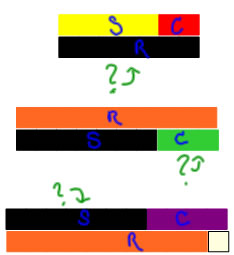 |
Separate problems: Connor had 8 markers. 2 of his markers dried out. How many markers did he have left? John had 10 toy cars. He gave some toy cars to Sam. Now he has 6 toy cars left. How many toy cars did he give to Sam? Ethan had some balloons. He gave 3 balloons to Kendra. Now he has 6 left. How many balloons did Ethan have to begin with? Notice:
|
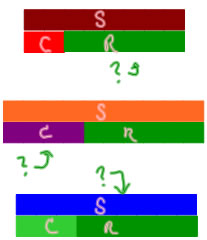 |
Part-Part-Whole: Kendra has 4 toy animals. Luke has 3 toy animals. How many toy animals do they have altogether? There are 6 people swimming in the pool. 4 of the people are adults. How many of the people are children |
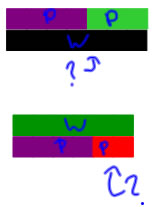 |
Compare: Gina has 7 red hats and 4 blue hats. How many more red hats than blue hats does Gina have? Jeff has 12 Lego people. Shane has 5 more Lego people than Jeff. How many Lego people does Shane have? Nathan has 9 green Jolly Ranchers. He has 6 more green Jolly Ranchers than purple Jolly Ranchers. How many purple Jolly Ranchers does he have? Notice: In compare problems there are two sets. One is bigger than the other. The fill-in amount is the difference. CQU vs CRU does not tell you which set is longer or shorter. I like to label the two sets that are being compared. "?" marks the unknown (which is one of the sets if it is CQU or CRU, and is the difference for CDU...of course). You can think of the bigger set being broken into parts one of which matches the smaller set, and the other of which is the difference. |
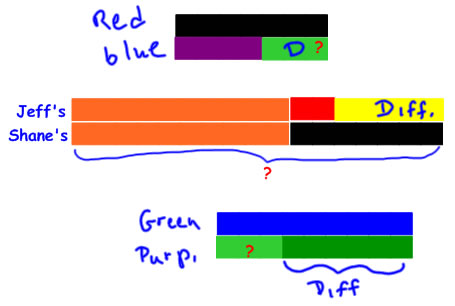 |